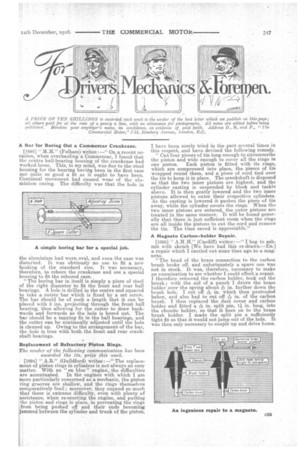A Bar for Boring Out a Commercar Crankcase.
Page 19

If you've noticed an error in this article please click here to report it so we can fix it.
[1693] " M.M." (Fulham) writes :—" On a recent occasion, when overhauling a Commercar, I found that the centre ball-bearing housing of the crankcase had worked loose. This, to my mind, Was due to the steel housing for the bearing havitg been in the first case notquite so good a fit as it ought to have been. Continual movement had caused wear of the aluminium casing. The difficulty was that the hole in
the aluminium had_ worn oval, and even the case was distorted. It was obviously no use to fit a new houting of the standard size, It was necessary, therefore, to rebore the crankcase and use a special housing to fit the rebored case. "The boring bar in itself is simply a piece of steel of the right diameter to fit the front and rear ball bearings. A hole is drilled in the centre and squared to take a cutter bar which is fixed by a set screw. The bar should be of such a length that it can be placed with 3 ins. projecting through the front ball bearing, thus allowing for the cutter to draw backwards and forwards as the hole is bored out. The bar should be a tapping fit in the ball bearings, and the cutter can be continually adjusted until the hole is cleaned up. Owing to the arrangement of the bar, the hole is true with both the front and rear crankshaft bearings.
Replacement of Refractory Piston Rings.
The sender of the following communication has been awarded the 10s. prize this week.
[1694] " A.B." (Guildford) writes :—" The replacement of piston rings in cylinders is not always an easy Matter. With an en bloc" engine, the difficulties are accentuated. In the engines with which I am more particularly concerned as a mechanic, the piston ring -grooves are shallow, and the rings themselves comparatively frail ; moreover, they expand so much that there is extreme difficulty, even with plenty of assistance, when re-erecting the engine, and putting the piston and rings in place, in preventing the rings from being pushed off and their ends becoming jammed between the cylinder and trunk of the piston. I have been sorely tried in the past several times in this respect, and have devised the following remedy. "Cut four pieces of tin long enough to circumscribe the piston and wide enough to cover all the rings in one piston. Each piston is fitted with its rings, which are compressed into place, the pieces of tin wrapped round them, and a piece of cord tied over the tin to keep it in place. The crankshaft is disposed so that the two inner pistons are highest, and the cylinder casting is suspended by block and tackle above. It is then gently lowered and the two inner pistons allowed to enter their respective cylinders. As the casting is lowered it pushes the piece of tin away, while the cylinder covers the rings. When the two inner pistons are entered, the outer pistons are treated in the same manner. It will be found generally that there is just sufficient room when the rings are all inside the pistons to cut the cord and remove the tin. The time saved is appreciable."
A Magneto Carbon-holder Repair.
[1695] " A.H.H." (Cardiff) write:—" I beg to submit with sketch [We have had this re-drawn.—ED.] a repair which I earned out some time ago to a magneto.
"The bead of the brass connection to the carbon brush broke off, and unfortunately a spare one was not in stock, it was, therefore, necessary to make an examination to see whether I could effect a repair. I therefore relnoved the carbon holder, took out the brush ; with the aid. of a punch I drove the brass holder over the spring about in. further down the brush hole. I cut off in. which then protruded
below, and also had to cut off 1.5e in. of the carbon brush. I then replaced the dust cover and carbon holder and fitted a 1.2-a in. split pin, 11 in. long, into the ebonite holder, so that it bore on to the brass brush holder. I made the split pin a sufficiently tight fit so that it would not jump out of the hole. It was then only necessary to couple 'up and drive home.




















